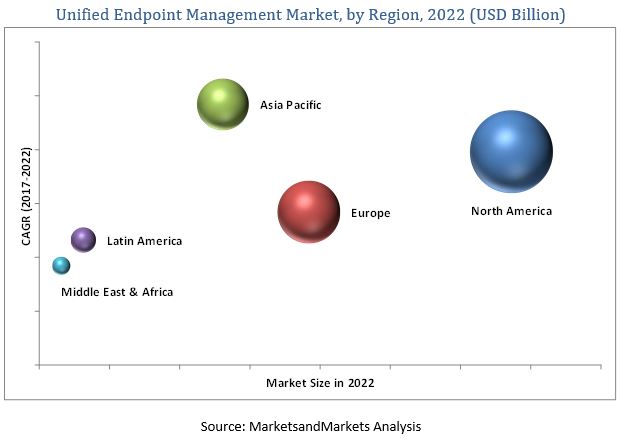The need for a single UEM solution that can manage traditional and non-traditional endpoints is one of the most significant factors projected to drive the growth of the market. The expansion of mobile workforces, proliferation of mobile apps, increased security threats, and the need to adhere to strict regulatory compliances regarding data security are additional factors contributing to the growth of the market. The inclusion of next-generation devices such as IoT devices and smart wearables in enterprises is expected to offer lucrative growth opportunities to UEM vendors in the near future.
Know More@ https://www.marketsandmarkets.com/Market-Reports/unified-endpoint-management-market-96801066.html
The unified endpoint management market has been segmented on the basis of type, organization size, vertical, and region. Based on type, the market has been classified into solutions and services. Based on organization size, the market has been segmented into large enterprises and Small & Medium-sized Enterprises (SMEs). Based on vertical, the market has been segmented into BFSI, telecommunication & IT, consumer goods & retail, government & defense, healthcare, manufacturing, transportation & logistics, automotive, and others (education and energy & utility). Based on region, the market has been segmented into North America, Europe, Asia Pacific, the Middle East & Africa, and Latin America.
Based on organization size, the unified endpoint management market has been segmented into large enterprises and SMEs. The Small & Medium-sized Enterprises (SMEs) segment of the market is projected to grow at a higher CAGR as compared to the large enterprises segment during the forecast period. The growth of the SMEs segment can be attributed to the increasing adoption of UEM solutions by SMEs to reduce operational cost and enhance enterprise security.
Based on vertical, the BFSI segment is estimated to lead the unified endpoint management market in 2017. The rising trend of Bring Your Own Device (BYOD) in the BFSI sector has contributed to the increased adoption of unified endpoint management solutions. Several companies in the BFSI sector are focused on enhancing workplace mobility, thereby improving employee productivity with the adoption of UEM solutions.
North America is estimated to be the largest market for unified endpoint management in 2017. The growth of the unified endpoint management market in North America is primarily driven by the presence of key UEM vendors, such as IBM (US), Microsoft US), Citrix Systems (US), VMware (US), BlackBerry (Canada), and MobileIron (US) in this region. The rising trend of BYOD and the increasing need to safeguard data stored in the cloud and transferred over networks are major factors projected to drive the growth of the market in North America.

The cost associated with the deployment of UEM solutions is higher as compared to traditional endpoint management solutions. A few organizations lack appropriate funds to adopt UEM solutions. Thus, high cost of deploying UEM solutions is acting as a restraint to the growth of the unified endpoint management market.
Key players operating in the market include VMware (US), Microsoft (US), IBM (US), MobileIron (US), BlackBerry (Canada), Citrix Systems (US), Ivanti (US), Sophos (UK), SOTI (Canada), Jamf (US), Symantec (US), CA Technologies (US), Cisco Systems (US), and Zoho (US). These companies are focused on the adoption of various growth strategies, such as new product launches, product enhancements, agreements, partnerships, and collaborations, to strengthen their position in the unified endpoint management market.
To speak to our analyst for a discussion on the above findings, click Speak to Analyst
No comments:
Post a Comment